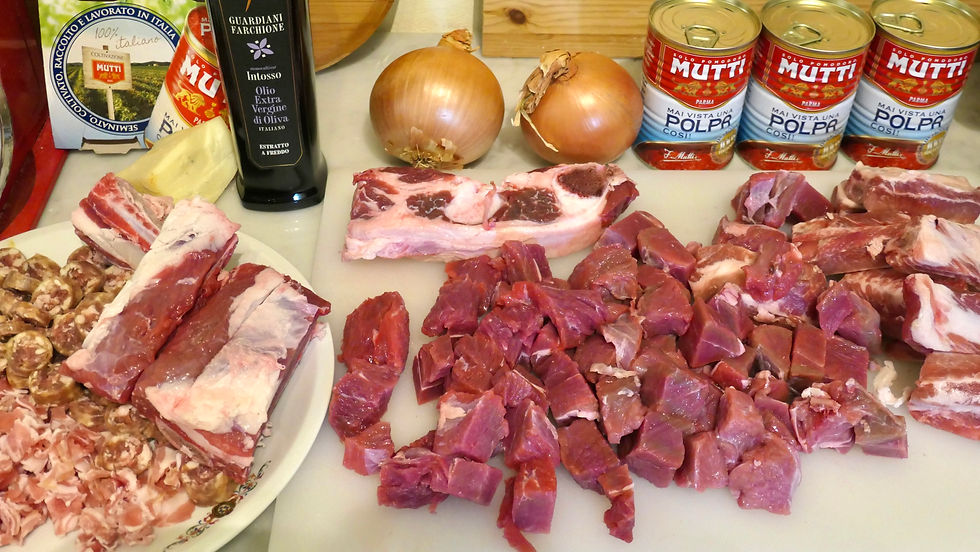Fava beans, peas and pecorino with pasta
- Mike
- Mar 12, 2021
- 3 min read
Updated: Nov 20, 2024
Casarecce ai baccelli, piselli e pecorino
Spring comes early in Italy and as soon as the calendar has turned the page to March, fresh fava (broad) beans and fresh peas appear in the supermarkets and the fruttivendoli. The Italian menu changes with the seasons and therein lies the beauty of the traditional diet here. There's nothing that says spring like a combination of fava beans, peas and pecorino but if you happen to be in Tuscany and go shopping for the ingredients for this recipe beware of the hidden meanings in certain words.

Elsewhere in Italy you can ask for le fave with no problem or embarrassment, but in Tuscany you need to say baccelli because fava is one of the many fruit and vegetable names that in colloquial Tuscan usage can refer to intimate body parts.
As this is a family publication I’ll leave it at that without further explanation, but it’s not just in the word 'fava' that danger lurks, also the Italian words for potato, fennel or even figs can cause a smirk. So, in the supermarket in Tuscany look for baccelli as there probably won’t be a sign saying fave.
That being said, the Tuscans are quite fond of baccelli and one of the traditional ways of eating them here is as an antipasto or snack with local pecorino cheese. The early crop of small baccelli are removed from their pods at the table and eaten raw accompanied by equally fresh young pecorino, often marzolino which is so named because it’s made in March for immediate consumption.

Our recipe of pasta with fava beans, peas and pecorino requires the same type of small fresh fava beans taken out of their pods but not subsequently shelled which many recipes involving fava beans seem to insist on.
Shelling them is not only a time-consuming process but unless the fava beans are large and a little old and tough, it’s completely unnecessary and it seems to be an added step to make the beans more attractive for finicky restaurant presentation. Don't do it.
Because the beans and peas in this recipe are cooked briefly rather than eaten raw, a nice aged pecorino is recommended (but not pecorino romano), otherwise parmigiano reggiano would be a perfectly acceptable substitute.
Ingredients for 2 people:
280 grams (10 oz) casarecce (or penne or other short pasta)
200 grams (7 oz) net weight of podded beans
140 grams (5 oz) net weight of shelled peas
1 small onion finely chopped
40 grams (1-2 oz) grated aged pecorino
1 large lemon (for juice and zest)
very little butter
extra virgin Italian olive oil
sea salt and freshly ground black pepper
Directions:
1. First, make a pesto as follows:
(i) Sweat the onion in a little oil and butter in a small pan over low heat for about 6 minutes without it taking on any color.
(ii) Add 120 grams (4.3 oz) of the beans and 60 grams (2.1 oz) of the peas to the pan with the onions, add very little water and cook with the lid on for only a couple of minutes on medium heat so they're mostly steamed.
(iii) Take off the heat, add a good dose of salt and pepper, a generous squeeze of lemon juice and some olive oil so the consistency is right for blending.
(iv) Puree with a hand blender for a few seconds, taste and adjust seasoning (it may need more salt), oil and lemon juice as needed. Put to one side to keep warm.
2. Put the pasta in salted boiling water. Grate the cheese and zest the lemon carefully without any of the white pith. Plenty of lemon zest is required for this dish.
3. A few minutes before the pasta is ready add the remaining beans and peas to a small pan with a little olive oil and salt and pepper and some of the pasta cooking water and cook for a couple of minutes.
4. Mix the cooked pasta with the fava beans, peas and reserved pesto. Add the grated pecorino and all the lemon zest. Add a slug of good quality olive oil and serve. The lemon zest and top quality Italian olive oil should really bring out the fresh flavor of the peas and beans.



